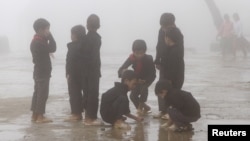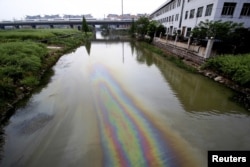Anxiety is growing among parents in eastern China about contaminated soil and underground water after nearly 500 students from a middle school developed illnesses that are possibly linked to chemical pollution at a nearby site.
The pollution scare is yet another reminder of the seriousness of China’s chemical pollution problem and exposes gaping holes in the country’s management of hazardous materials, analysts say.
State-owned CCTV reports 493 students from Changzhou Foreign Language School in Jiangsu province have fallen ill, diagnosed with dermatitis, bronchitis and white blood cell deficiencies, as well as a few cases of cancer, including lymphoma and leukemia.
Parents suspected the symptoms were likely triggered by extremely high levels of groundwater and soil pollution because the school is adjacent to the sites of three former pesticide plants, including the local arm of Shenzhen Noposion Agrochemicals Company, one of China’s largest pesticide makers.
The CCTV report quoted students and parents complaining about the water, tasting “a bit sour,” and a smell “like rotten duck eggs” in the air after students begun their studies here in December of last year.
Wrong site
The state media concluded the school shouldn’t have been built on the “toxic plot of land,” citing an environmental assessment report released prior to its construction last year.
Earlier, investigative news reports suggested that, based on groundwater samples, the level of chlorobenzene, which is used to make pesticides and is harmful to human nervous systems, livers and kidneys, exceeded national standards by more than 94,000 times.
Another report by Caixin Media further confirmed that one plant had buried toxic waste before it moved away in 2010, citing its former employees.
“From this Changzhou case, it’s quite obvious that the factories were illegally dumping some hazardous wastes [be]cause those were very poisonous wastes,” said Ada Kong, Greenpeace East Asia toxics campaign manager.
Kong added the tragedy shows how “dangerously lax” China’s management of hazardous materials is as the country’s chemical industry has been loosely regulated with its use and discharge of hazardous materials.
That has long caused serious problems for many local governments, which have rezoned industrial sites without knowing how much chemical waste had been discharged on site, according to Kong.
Worrying parents nationwide
The pollution scare in Changzhou has worried parents elsewhere.
On the social media site Weibo, one user said that similar concerns were expressed by parents of another school further east in Nantong City, when “parents began to gather in front of the city government [to petition].But in response, the local government sent armed police.”
Another user posted comments, which read, “This is hundreds of times worse than the chemical disaster in the port of Tianjin, [which killed 165 people.]... Those hazardous materials were as toxic as nuclear wastes.”
Several users further mocked local government officials, who they said “should move to and work in the school’s vicinity” to have a real taste of what it is like under the threat of a polluted environment.
The school and local government officials have repeatedly disputed the media reports, insisting that claims of mass illnesses are groundless.
After the case gained national attention, the city government on Monday emphasized in a written statement that it has “zero tolerance” for any occurrence of pollution and has put together a task force to further investigate.
“Now that an investigation team has been in place, we await for final results,” said a school teacher over the phone, who refused to be identified.
The school reiterated that claims of massive illness were exaggerated since only four of the school’s 2,451 students and three of its 210-member faculty are currently on sick leave, while another five students plan to transfer to another school.
Pollutant vapor intrusion
Although further environmental tests are necessary, initial findings from the local media have provided plausible explanations behind the students’ illness, said Yao Yijun, an associate professor with the College of Environmental & Resource Science at Zhejiang University
“Although pollutants were only discovered in the further north, they could have reached the underground water pipelines, which are inter-connected,” Yao said.
“Through the pipelines, I suspect these pollutants have migrated from the north and moved southbound to further contaminate the soil near the school,” he said.
From contaminated soil, a vapor intrusion must have occurred to threaten the health of students, the professor assumed.
But Yao dismissed the likelihood of students having conditions as severe as cancer because of exposure within a few months, saying most illnesses linked to pollution are developed over a decade or more.
The best solution now is to relocate the school’s contaminated soil elsewhere for neutralization, the professor said, adding that the level of soil contamination in Jiansu may be worse than expected, as the province had shut down 7,000 factories between 2010 and 2015.
Yao urged the Chinese government to aggressively tackle the issue by hiking its annual budget for soil contamination from $309 million to an estimated $10.8 billion, or 0.1 percent of its GDP as U.S. experience has shown.









